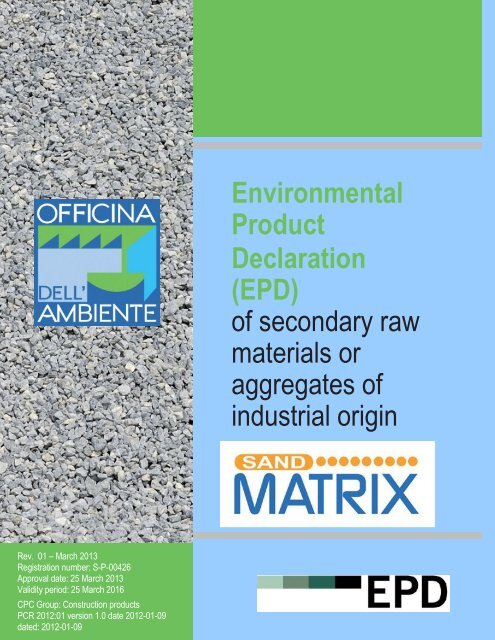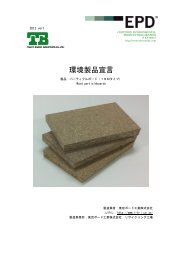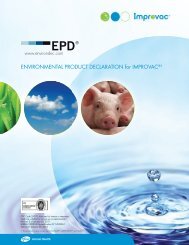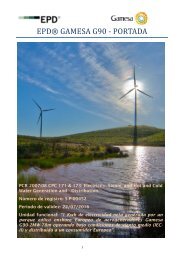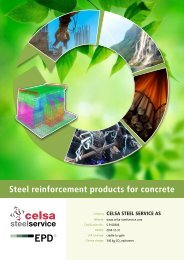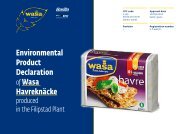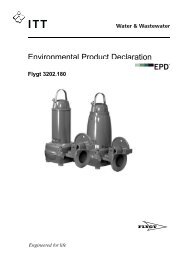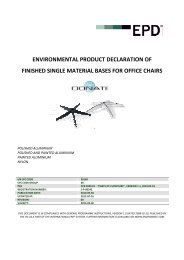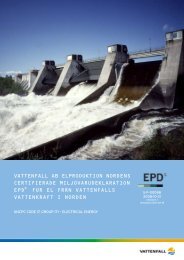EPD Sand Matrix - The International EPD® System
EPD Sand Matrix - The International EPD® System
EPD Sand Matrix - The International EPD® System
You also want an ePaper? Increase the reach of your titles
YUMPU automatically turns print PDFs into web optimized ePapers that Google loves.
Environmental<br />
Product<br />
Declaration<br />
(<strong>EPD</strong>)<br />
of secondary raw<br />
materials or<br />
aggregates of<br />
industrial origin<br />
Rev. 01 – March 2013<br />
Registration number: S-P-00426<br />
Approval date: 25 March 2013<br />
Validity period: 25 March 2016<br />
CPC Group: Construction products<br />
PCR 2012:01 version 1.0 date 2012-01-09<br />
dated: 2012-01-09
1 DESCRIPTION OF THE COMPANY AND THE PRODUCT<br />
1.1 <strong>The</strong> company<br />
Officina dell’Ambiente S.p.A, located<br />
in the municipality of<br />
Lomello in Pavia province, performs<br />
the treatment and recovery<br />
process of special hazardous and<br />
non-hazardous wastes, mainly<br />
bottom ashes derived from municipal incineration<br />
plants to be re-used as secondary raw material<br />
for the production of cement and other building<br />
materials.<br />
Thousands of tonnes of bottom ashes from incineration,<br />
instead of being disposed in landfill, are<br />
treated in a controlled manner through a treatment/recovery<br />
cycle which generates a secondary<br />
raw material, named <strong>Matrix</strong>®, as substitute<br />
of primary raw material for cement production<br />
and other building products.<br />
Today, <strong>Matrix</strong> has become a family of products<br />
with different characteristics, particle size and<br />
application ranging over almost all building sectors.<br />
At the moment, representatives of the <strong>Matrix</strong><br />
Family are:<br />
<strong>Matrix</strong> Standard, with a particle size between<br />
0 and 10 mm;<br />
AG<strong>Matrix</strong>, with a particle size between 2<br />
and 10 mm; this product has been EClabelled<br />
as aggregate for concrete in<br />
2008;<br />
<strong>Sand</strong> <strong>Matrix</strong>, a group of sands that can be<br />
produced in particle size of 0-2 mm, 0-4<br />
mm and 2-4 mm.<br />
1.2 <strong>Sand</strong> <strong>Matrix</strong> ®<br />
<strong>The</strong> main process of Officina dell’Ambiente S.p.A.<br />
is aimed to obtain the product named <strong>Matrix</strong><br />
Standard, starting from bottom ashes derived<br />
from municipal incineration plants. <strong>The</strong> process<br />
involves a set of physical-mechanical treatments,<br />
without the addition of chemical reagents, consisting<br />
of a screening, crushing and separation of<br />
ferrous and non-ferrous metals.<br />
More in detail, the main production process of<br />
Officina dell’Ambiente S.p.A. consists of the following<br />
phases:<br />
acceptance of the waste;<br />
<strong>The</strong> recovery of incineration bottom ashes, otherwise<br />
disposed in landfill, allows to conserve resources<br />
mitigating the demand for raw materials<br />
and the depletion of natural resources.<br />
Officina dell’Ambiente S.p.A. complies with European<br />
Union Directives that provide a management<br />
policy aimed at minimizing waste production,<br />
focusing on their recovery rather than their<br />
disposal.<br />
Officina dell’Ambiente S.p.A. supplies several cement<br />
plants and producers of concrete with a<br />
wide range of products as substitutes of primary<br />
raw materials with the dual purpose of removing<br />
a considerable flow of waste from landfill and to<br />
preserve the reserves of natural materials.<br />
Officina dell’Ambiente S.p.A. holds the Environmental<br />
Management <strong>System</strong> certificate according<br />
to the scheme of UNI EN ISO 14001:2004, which<br />
has the following scope: treatment and recovery<br />
of specific hazardous and non-hazardous waste<br />
through the phases of weighing, unloading, storage<br />
and physical-mechanical separation.<br />
<strong>The</strong> headquarters of Officina dell’Ambiente S.p.A,<br />
which corresponds to the production site, is the<br />
following:<br />
Strada Provinciale 193bis – Tenuta Grua, Lomello<br />
(PV)<br />
This site is registered under EC Regulation<br />
1221/09 EMAS from 30/8/2006 with the number<br />
555 (Environmental verifier DNV Italy).<br />
unloading of the waste in specific areas of<br />
the production site;<br />
waste maturation process;<br />
loading of the waste through loading<br />
hoppers and transferring to the treatment<br />
plant;<br />
screening and separation of the waste;<br />
crushing and separation of ferrous metals<br />
from unscreened waste;<br />
storage of <strong>Matrix</strong> Standard in specific areas<br />
of the production site;<br />
- 1 -
picking and selling of the finished product.<br />
Following the production of <strong>Matrix</strong> Standard, Officina<br />
dell’Ambiente has built in the external area<br />
of the plant a system of vibrating sieves working<br />
without the use of water, which separates <strong>Matrix</strong><br />
Standard into the fractions with particle size 0-4<br />
mm, 2-10 mm and >10 mm (which is sent back to<br />
the crushing system). <strong>The</strong> fraction with particle<br />
size 0-4 mm (<strong>Sand</strong> <strong>Matrix</strong> 0-4 mm) is further<br />
separated into the fractions with particle size 0-2<br />
mm (<strong>Sand</strong> <strong>Matrix</strong> 0-2 mm) and 2-4 mm (<strong>Sand</strong><br />
<strong>Matrix</strong> 2-4 mm) using the vibrating sieves.<br />
All <strong>Sand</strong> <strong>Matrix</strong> products (0-2, 0-4, 2-4 mm) own<br />
characteristics and specific EC marking for various<br />
sectors, such as the production of concrete,<br />
pre-measured mortars, bituminous conglomerate,<br />
brick and cement mixtures.<br />
As required by PCR document 2012:01, in <strong>Matrix</strong><br />
products there are no substances with a high degree<br />
of concern (SVHC) provided in the ECHA<br />
Candidate List with a concentration greater than<br />
0,1%.<br />
Product U.M.<br />
Quantity<br />
2009 2010 2011 average<br />
<strong>Sand</strong> <strong>Matrix</strong> 0-2 mm ton 3.458 1.927 25.990 10.459<br />
<strong>Sand</strong> <strong>Matrix</strong> 2-4 mm ton 0 0 3.022 1.007<br />
<strong>Sand</strong> <strong>Matrix</strong> 0-4 mm ton 10.975 7.361 7.974 8.770<br />
Table 1: Quantity of <strong>Sand</strong> <strong>Matrix</strong> sold from 2009 to 2011<br />
Declared Unit<br />
1000 kg of <strong>Matrix</strong> product<br />
<strong>The</strong> phases of distribution, use and disposal of the product are not included in the study<br />
1.3 Composition of the product<br />
Parameter U.M. <strong>Sand</strong> <strong>Matrix</strong> Parameter U.M. <strong>Sand</strong> <strong>Matrix</strong><br />
Humidity % 14,58 As mg/kg 13,45<br />
SiO 2 % s.s. 31,52 Cd mg/kg 16,55<br />
Al 2O 3 % s.s. 11,94 Cr (total) mg/kg 737,55<br />
Fe 2O 3 % s.s. 11,32 Cr (VI) mg/kg < 1<br />
CaO % s.s. 20,49 Cu mg/kg 5.890,00<br />
MgO % s.s. 2,74 Hg mg/kg < 5<br />
Na 2O % s.s. 2,10 Mn mg/kg 1.244,36<br />
K 2O % s.s. 0,90 Ni mg/kg 233,36<br />
TiO 2 % s.s. 0,99 Pb mg/kg 3.180,55<br />
Mn 2O 3 % s.s. 0,18 Sb mg/kg 138,09<br />
Cr 2O 3 % s.s. 0,11 Se mg/kg < 5<br />
S (total) % s.s. 0,57 V mg/kg 37,55<br />
SO 3 % s.s. 1,42 Zn mg/kg 5.772,09<br />
P 2O 5 % s.s. 1,76<br />
Cl % s.s. 0,45<br />
CaCO 3 % s.s. 11,41<br />
Loss on ignition<br />
(550°C)<br />
% s.s. 7,92<br />
Table 2: Average chemical composition of <strong>Sand</strong> <strong>Matrix</strong> produced in 2011<br />
- 2 -
1.4 <strong>System</strong> boundaries<br />
<strong>System</strong> boundaries determine the unit processes<br />
to be included in LCA study and which data<br />
as "input" and/or "output" to/from the system<br />
can be omitted. According to the PCR 2012:01,<br />
the life cycle of <strong>Matrix</strong> products is divided into<br />
upstream and core phases, as specified below.<br />
<strong>The</strong> upstream phase comprises the supply of<br />
raw materials and specifically:<br />
the extraction and processing of raw<br />
materials and recycling processes of the<br />
secondary raw materials from the previous<br />
product system (with the exception<br />
of the processes which are part of<br />
the waste treatment of the previous<br />
product system);<br />
the electricity generation from primary<br />
energy sources, including their extraction,<br />
refining and distribution;<br />
energy recovery from secondary fuels<br />
(with the exception of processes which<br />
are part of the waste treatment in the<br />
system of the previous product).<br />
<strong>The</strong> core phase includes the following processes:<br />
external and internal transport between<br />
processes belonging to the core phase;<br />
production of <strong>Matrix</strong> products;<br />
treatment of waste derived from the<br />
production of <strong>Matrix</strong> products.<br />
<strong>The</strong> downstream phase is not included in the<br />
system boundaries. In the figure below it is<br />
shown the schematic diagram of the life.<br />
BOTTOM ASH FROM<br />
INCINERATOR<br />
BOTTOM ASH FROM POWER PLANT<br />
RAW MATERIAL EXTRACTION<br />
PRODUCTION OF MATERIAL AND FUEL<br />
ELECTRICITY GENERATION<br />
ELETTRICA<br />
UPSTREAM PROCESSES<br />
UPSTREAM PROCESSES<br />
PRODUCTION OF MATRIX PRODUCTS – OFFICINA DELL’AMBIENTE SPA<br />
CORE PROCESSES<br />
DISTRIBUTION USE DISPOSAL OF THE PRODUCT<br />
DOWNSTREAM PROCESSES<br />
LEGEND:<br />
TRANSPORTATION<br />
INPUT FROM OTHER<br />
PRODUCT SYSTEMS<br />
EMISSIONS AND OTHER<br />
WASTE LEAVING THE<br />
PRODUCT SYSTEM<br />
PHASES OR FLOWS NOT<br />
CONSIDERED<br />
Figure 1: <strong>System</strong> boundaries<br />
- 3 -
1.5 Data quality<br />
<strong>The</strong> inventory analysis was conducted using specific<br />
data provided by Officina dell’Ambiente SpA<br />
concerning the consumption of raw materials<br />
and electricity, the production of <strong>Matrix</strong> products<br />
and related waste. All data refer to the last three<br />
years (2009, 2010 and 2011) while in the model<br />
the average values were used. <strong>The</strong> electricity<br />
consumed by Officina dell’Ambiente is produced<br />
from hydroelectric and photovoltaic sources.<br />
Selected generic data was used from international<br />
databases (in particular Ecoinvent 2.2) regarding<br />
the production processes of the auxiliary materials<br />
used for the production of <strong>Matrix</strong> products,<br />
the processes of generation and distribution<br />
of electricity, the means of transportation and<br />
waste treatment processes related to the production<br />
of <strong>Matrix</strong> products. Furthermore, the distances<br />
of transportation were calculated using<br />
Google Maps online calculator. Generic data was<br />
not used.<br />
According to the PCR 2012:01, the following processes<br />
were excluded: the maturation process of<br />
the bottom ash, the accumulation and the process<br />
of natural weathering of the <strong>Matrix</strong> Standard because<br />
less than 1% of the total impact; the consumption<br />
of natural gas for heating offices, the<br />
travels of workers to and from work and the construction<br />
of machinery and plants, as not directly<br />
related to the product.<br />
1.6 Distribution, use phase and disposal of the product<br />
<strong>The</strong> distribution of the product, use phase and<br />
disposal of <strong>Matrix</strong> products were not considered<br />
(“cradle-to-gate" LCA study, i.e. from cradle to<br />
the gate of the company).<br />
1.7 Comparison of <strong>EPD</strong> within the same product category<br />
<strong>The</strong> <strong>EPD</strong> within the same product category but<br />
which refer to different programs can not be<br />
compared.<br />
<strong>Sand</strong> <strong>Matrix</strong> products described in this document<br />
is based on specific PCR 2012:01 version 1.0 dated<br />
09-01-2012.<br />
1.8 Validity of <strong>EPD</strong><br />
This <strong>EPD</strong> refers to the geographical area of Italy<br />
and remains valid until the 1 st of March 2016.<br />
- 4 -
2 ENVIRONMENTAL PERFORMANCE<br />
<strong>The</strong> environmental performance of <strong>Sand</strong> <strong>Matrix</strong><br />
products, as described below, is based on the<br />
methodology of Life Cycle Assessment (LCA) and<br />
it was calculated in accordance with ISO 14040<br />
and 14044, the <strong>International</strong> <strong>EPD</strong> system and<br />
PCR 2012:01. <strong>The</strong> management and update of<br />
environmental data concerning <strong>EPD</strong> products are<br />
regulated by a specific procedure in the manual<br />
for the management systems of safety and the<br />
environment (EMAS). <strong>The</strong> radioactivity of bottom<br />
ash from incineration of municipal waste is<br />
monitored before sending to Officina<br />
dell’Ambiente in order to exclude the delivery of<br />
radioactive bottom ash.<br />
1.9 Assessment methodology<br />
<strong>The</strong> calculation method adopted for the LCA<br />
study of the present <strong>EPD</strong> is described in the document<br />
"GPI for an <strong>International</strong> <strong>EPD</strong> ® <strong>System</strong>"<br />
and the characterization factors used to convert<br />
the data deriving from the inventory analysis of<br />
the life cycle into impact categories are listed in<br />
"Appendix B: Conversion and characterization<br />
factors". In addition to the impact categories required<br />
by PCR, the impact categories related to<br />
aquatic and terrestrial ecotoxicity, human toxicity<br />
and land use were also considered; these impact<br />
categories taken from the CML 2001 method<br />
developed by the Center of Environmental Science<br />
(CML) of Leiden University in the Netherlands<br />
(http://cml.leiden.edu/software/datacmlia.html).<br />
1.10 Environmental profile of <strong>Sand</strong> <strong>Matrix</strong> ®<br />
<strong>The</strong> impact categories, which characterize upstream<br />
and core phases and the life cycle of <strong>Sand</strong><br />
<strong>Matrix</strong> 0-4 mm, refer to one tonne of product and<br />
as presented in the following table. <strong>The</strong> results of<br />
the impact categories of <strong>Sand</strong> <strong>Matrix</strong> 0-2 mm and<br />
<strong>Sand</strong> <strong>Matrix</strong> 2-4 mm are not shown because, according<br />
to the GPI document, the difference from<br />
the <strong>Matrix</strong> <strong>Sand</strong> 0-4 mm is less than 5% for all<br />
impact categories (the maximum percentage difference<br />
is 0,4%). Resources whose contribution<br />
is greater than 5% of the total impact of one ton<br />
of <strong>Sand</strong> <strong>Matrix</strong> 0-4 mm, are also shown.<br />
- 5 -
Impact Category U.M. Upstream Core Life cycle<br />
Non renewable resources without energy content kg 0,002 0,080 0,082<br />
Non renewable resources with energy content MJ eq 1,660 534,438 536,098<br />
Renewable resources without energy content kg 0,000 0,024 0,024<br />
Renewable resources with energy content MJ eq 32,100 0,846 32,946<br />
Water consumption litre 127.237,73 5.416,28 132.654,01<br />
Electricity consumption in the core MJ n.a. 31,569 n.a.<br />
Global warming potential 100 years kg CO 2 eq 0,041 44,357 44,398<br />
Ozone depletion mg CFC-11 eq 0,008 4,978 4,986<br />
Photochemical smog oxidation g C 2H 4 0,130 34,528 34,658<br />
Acidification g SO 2 eq 0,142 199,564 199,706<br />
Eutrophication g PO 4--- eq 0,034 54,073 54,107<br />
Human toxicity 100 years kg 1,4-DB eq 0,021 5,753 5,774<br />
Water toxicity 100 years kg 1,4-DB eq 0,004 58,491 58,495<br />
Marine water ecotoxicity kg 1,4-DB eq 0,016 186,027 186,043<br />
Soil ecotoxicity 100 years kg 1,4-DB eq 0,000 0,002 0,002<br />
Land use m 2 a 0,000 0,010 0,010<br />
<strong>The</strong> use of renewable secondary raw materials kg 0,000 0,000 0,000<br />
<strong>The</strong> use of non renewable secondary raw materials kg 0,000 1,261 1,261<br />
Reusable components kg 0,000 0,000 0,000<br />
Recyclable materials kg 0,000 117,136 117,136<br />
Materials for energy recovery kg 0,000 0,000 0,000<br />
Non-hazardous waste kg 0,038 11,653 11,691<br />
Hazardous waste kg 0,001 0,046 0,047<br />
Radioactive waste m 3 0,000 0,000 0,000<br />
Table 3: <strong>The</strong> environmental impacts of 1 tonne of <strong>Sand</strong> <strong>Matrix</strong> 0-4 mm<br />
- 6 -
Consumption of non renewable<br />
resources without energy<br />
content<br />
U.M.<br />
Life cycle<br />
Consumption of non renewable<br />
resources with<br />
energy content<br />
U.M.<br />
Life cycle<br />
Sodium chloride kg 0,044 Oil MJ 494,564<br />
Calcite kg 0,032 Natural gas MJ 30,718<br />
Other resources kg 0,006 Other resources MJ 10,816<br />
Total resources kg 0,082 Total resources MJ 536,098<br />
Table 4: Non renewable resources whose contribution is greater than 5% of the total impact of one ton of <strong>Sand</strong> <strong>Matrix</strong> 0-4<br />
mm<br />
Consumption of renewable<br />
resources without energy<br />
content<br />
U.M.<br />
Life cycle<br />
Consumption of renewable<br />
resources with energy content<br />
U.M.<br />
Life cycle<br />
Carbon dioxide in air kg 0,016 Hydroelectric energy MJ 29,465<br />
Softwood kg 0,005 Solar energy MJ 3,256<br />
Hardwood kg 0,003 Other resources MJ 0,225<br />
Other resources kg 0,000 Total resources MJ 32,946<br />
Total resources kg 0,024<br />
Table 5: Renewable resources whose contribution is greater than 5% of the total impact of one ton of <strong>Sand</strong> <strong>Matrix</strong> 0-4 mm<br />
Water consumption U.M. Life cycle<br />
For hydroelectric production litre 131996,070<br />
Other uses litre 657,933<br />
Total consumption litre 132654,010<br />
Table 6: Water consumption for the production of one ton of <strong>Sand</strong> <strong>Matrix</strong> 0-4 mm<br />
- 7 -
1.11 Additional environmental information<br />
Comparison between <strong>Sand</strong> <strong>Matrix</strong> and sand production<br />
<strong>Sand</strong> <strong>Matrix</strong> 0-2 mm was compared with sand,<br />
whose life cycle includes the extraction of the<br />
raw material, the handling inside the cave and<br />
the treatment of the extracted material; the life<br />
cycle of the sand was obtained from the Ecoinvent<br />
database (process “<strong>Sand</strong>, at mine/IT U”<br />
modified with the Italian energy mix), ETH database<br />
(process “<strong>Sand</strong> ETH U”) and ELCD database<br />
(process “<strong>Sand</strong> 0/2, wet and dry quarry, production<br />
mix, at plant, undried RER S”). <strong>The</strong> following<br />
table presents the results of the comparison relative<br />
to 1 ton of product.<br />
Impact category<br />
U.M.<br />
<strong>Sand</strong><br />
<strong>Matrix</strong><br />
0-2 mm<br />
<strong>Sand</strong> <strong>Matrix</strong><br />
0-2 mm<br />
with avoided<br />
impacts<br />
of slag<br />
disposal<br />
<strong>Sand</strong> <strong>Matrix</strong><br />
0-2 mm<br />
with avoided<br />
impacts<br />
of slag<br />
disposal and<br />
primary<br />
production<br />
of iron and<br />
aluminium<br />
<strong>Sand</strong><br />
(Ecoinvent)<br />
<strong>Sand</strong><br />
(ETH)<br />
<strong>Sand</strong><br />
(ELCD)<br />
Non renewable resources<br />
without energy content<br />
kg 0,082 0,081 -111,798 1.040,023 1.000,014 430,073<br />
Non renewable resources<br />
with energy content<br />
MJ eq 535,859 506,719 -95,566 46,139 150,554 28,831<br />
Renewable resources<br />
without energy content<br />
kg 0,024 0,023 -0,200 0,089 0,002 7,859<br />
Renewable resources<br />
without energy content<br />
MJ eq 32,916 32,870 24,773 3,002 2,918 2,358<br />
Water consumption litre 132.535,030 132.275,510 79.794,124 13.016,932 14.455,569 4,197<br />
Global warming<br />
potential 100 years<br />
kg CO 2 eq 44,382 42,303 -2,197 2,953 9,758 2,448<br />
Ozone depletion mg CFC-11 eq 4,984 4,719 2,596 0,355 10,355 0,181<br />
Photochemical<br />
smog formation<br />
g C 2H 4 34,625 31,938 -65,092 3,249 26,118 2,018<br />
Acidification g SO 2 eq 199,579 187,036 -122,099 14,689 40,524 17,105<br />
Eutrophication g PO 4--- eq 54,078 -461,733 -532,857 3,843 5,935 2,022<br />
Human toxicity kg 1,4-DB eq 5,765 -6,273 -41,044 0,969 1,019 0,085<br />
Water ecotoxicity kg 1,4-DB eq 58,495 -2.022,287 -2.059,610 0,242 0,510 0,001<br />
Marine water<br />
ecotoxicity<br />
kg 1,4-DB eq 186,041 -6.457,512 -6.592,230 0,967 2,648 0,066<br />
Soil ecotoxicity kg 1,4-DB eq 0,002 -0,001 -0,028 0,000 0,001 0,000<br />
Land use m 2 a 0,010 -0,413 -0,587 0,298 0,000 0,000<br />
Table 7: Results of the comparison between <strong>Sand</strong> <strong>Matrix</strong> 0-2 mm (without and with avoided impacts) and sand<br />
- 8 -
From the table above, it can be noticed that there<br />
is a reduced consumption of non renewable resources<br />
without energy content of <strong>Sand</strong> <strong>Matrix</strong> as<br />
a result of the waste recovery (which are secondary<br />
raw materials), while the consumption of non<br />
renewable resources with energy content of <strong>Sand</strong><br />
<strong>Matrix</strong> is mainly due to the transport of bottom<br />
ash from incinerators to Officina dell’Ambiente<br />
SpA; the consumption of renewable resources<br />
without energy content is not significant as it is<br />
related to biomass used for the production of<br />
electricity in the energy mix of European countries.<br />
Instead, the consumption of renewable resources<br />
with energy content indicates that the extraction<br />
of the sand relies on traditional resources (fossil<br />
fuels) which is of the same order of magnitude as<br />
the consumption of electricity from renewable<br />
sources of Officina dell’Ambiente (excluding the<br />
process of ETH database). <strong>The</strong> water consumption<br />
is higher in the production of <strong>Sand</strong> <strong>Matrix</strong><br />
because it refers for 99% to the production of<br />
electricity from hydroelectric source while the<br />
consumption related to the manufacturing process<br />
is lower than the water consumption of the<br />
sand (compared with the process of Ecoinvent<br />
database).<br />
With regard to the indicators of global warming<br />
potential, depletion of the ozone layer, the formation<br />
of photochemical smog, acidification and<br />
eutrophication potentials, all impact categories<br />
are higher in the life cycle of <strong>Sand</strong> <strong>Matrix</strong> (compared<br />
with the process of Ecoinvent database):<br />
that is due to the higher consumption of fossil<br />
fuels.<br />
Regarding toxicity indicators, all impact categories<br />
are higher in the life cycle of the <strong>Sand</strong> <strong>Matrix</strong><br />
due to the higher consumption of fossil fuels and<br />
processes for the disposal of waste.<br />
With regards to the comparison between the<br />
scenarios of <strong>Sand</strong> <strong>Matrix</strong> with and without avoided<br />
impacts of bottom ash, the greatest benefit is<br />
evident in the indicator of eutrophication as a result<br />
of avoided emissions into water of nitrate,<br />
phosphate and COD released by bottom ash.<br />
With regards to the comparison between the<br />
scenarios of <strong>Sand</strong> <strong>Matrix</strong> with and without avoided<br />
impacts of bottom ash disposal in landfill (calculated<br />
modifying process “disposal, municipal<br />
solid waste, 22.9% water, to municipal incineration/kg/CH”<br />
of Ecoinvent database) and the primary<br />
production of iron and aluminium (calculated<br />
with processes “Sinter, iron, at plant/GLO<br />
U” and “Aluminium hydroxide, at plant/RER U” of<br />
Ecoinvent database), the greatest benefits are evident<br />
in the indicators of non renewable resources,<br />
with and without energy content and<br />
water consumption, due to the avoided supply of<br />
raw materials and fossil fuels (the latter contributes<br />
to the reduction of global warming potential);<br />
also in the indicator of formation of photochemical<br />
smog, due to the avoided emission of<br />
carbon monoxide derived from primary production<br />
of iron; also in the indicator of acidification,<br />
due to the avoided emission of sulphur dioxide<br />
derived from the primary production of iron.<br />
Quality of <strong>Matrix</strong> products<br />
Officina dell’Ambiente S.p.A. applies a production<br />
cycle that includes a series of selflimitations<br />
with the aim to further increase the<br />
level of assurance of the already high technical<br />
standards of the <strong>Matrix</strong> ®. In particular, bottom<br />
ashes produced by incinerators that treat special<br />
industrial waste are never delivered to Officina<br />
dell’Ambiente, even if that bottom ash<br />
could be theoretically compatible for its chemical<br />
and physical properties; other types of<br />
waste are never delivered and treated, even if Officina<br />
dell’Ambiente is authorized to receive different<br />
EWC code waste, therefore mixing of wastes<br />
does not occur; waste from storage centres is never<br />
delivered to Officina dell’Ambiente but only ash<br />
produced by individual furnaces is accepted, so as<br />
to maintain a clear traceability and specificity of the<br />
incoming material. Environmental controls on <strong>Matrix</strong><br />
® Family are performed to ensure products<br />
with consistent quality and environmental charac-<br />
- 9 -
teristics compatible with the limits of the law<br />
and regulations. All <strong>Matrix</strong> products are subject<br />
to strict controls: analysis includes the major<br />
inorganic constituents and heavy metals and<br />
are carried out on samples that represent the<br />
average production of the plant. Main organic<br />
pollutants are regularly measured on a monthly<br />
basis in the <strong>Matrix</strong> ® Standard and their values<br />
are always equal to zero or extremely low. Officina<br />
dell’Ambiente has set up a chemical laboratory<br />
equipped with modern instrumentation<br />
and directed by a chemist regularly enrolled<br />
with the professional Order. <strong>The</strong> instrumental<br />
equipment is able to realize inorganic analysis<br />
with particular reference to complex mineralogical<br />
matrices such as slag from incineration (ball<br />
mills, digester oven, muffle for mergers alkaline, inductively<br />
coupled plasma spectrometer for the determination<br />
of metals). In addition physical and<br />
mechanical tests are performed, as required to<br />
maintain the EC labels, and the same laboratory is<br />
suitable for carrying out independently mixtures of<br />
concrete and mortar together with a number of<br />
measurements according to the UNI EN rules. Alternatively,<br />
highly qualified external laboratories<br />
are employed.<br />
Product certification<br />
According to Directive 89/106/EC, building materials<br />
may be sold only if they possess EC marking<br />
in accordance to the corresponding technical<br />
standard. For almost all of the applications of <strong>Matrix</strong><br />
products, EC marking is required.<br />
Obtaining this marking requires the existence of<br />
the Quality Control <strong>System</strong>, known as FPC (Factory<br />
Production Control) that once implemented is<br />
subject to certification by an independent body<br />
(ICMQ, certificate number 1305-CPD-0661). Officina<br />
dell’Ambiente S.p.A. has been certified at<br />
the beginning of 2008 and the FPC system covers<br />
four products for a total of eight EC marking in<br />
accordance with the technical standard.<br />
All products of the <strong>Matrix</strong> Family play an important<br />
role in the LEED certification scheme as<br />
they contribute to the achievement of credits related<br />
to the section "Materials and resources" either<br />
for category 4 (recycled content) and category<br />
5 (regional materials) . To facilitate the acquisition<br />
of credits by customers working in ecosustainable<br />
building, the recycled content in <strong>Matrix</strong><br />
products, which is equal to 100% postconsumer<br />
waste, has been established using the<br />
requirements of the standard ISO 14021. <strong>The</strong> result<br />
is a self-declared environmental statement<br />
(in accordance with ISO 14021) whose accuracy<br />
has been subjected to independent validation of<br />
ICMQ certification.<br />
Improvement goals<br />
Based on the results of the LCA study and maintaining<br />
what has already been reported in the<br />
EMAS Environmental Declaration, improvement<br />
goals set by Officina dell’Ambiente for <strong>Matrix</strong><br />
products include the extension of the CE marking<br />
to one more <strong>Matrix</strong> product at least and the reduction<br />
of environmental impacts of <strong>Matrix</strong> products<br />
through the review of the logistics of transporting<br />
of waste input.<br />
- 10-
3 REFERENCES<br />
Valutazione del ciclo di vita della famiglia di prodotti <strong>Matrix</strong> ® : <strong>Matrix</strong> ® Standard, <strong>Sand</strong> <strong>Matrix</strong> ® e<br />
AG<strong>Matrix</strong> ® , Ambiente Italia srl, 22 Febbraio 2013<br />
Dichiarazione Ambientale EMAS, Officina dell’Ambiente S.p.a., Reg. 1221/2009, Anno 2011<br />
General Programme Instructions for Environmental Product Declarations, version 1.0 dated<br />
2008-02-29PCR 2012:01 versione 1.0 datata 2012-01-09; Gruppo CPC: Construction products<br />
PCR 2012:01 versione 1.0 datata 2012-01-09; Gruppo CPC: Construction products<br />
ISO 14040:2006 Environmental management – Life cycle assessment - Principles and Framework<br />
ISO 14044:2006 Environmental management – Life cycle assessment – Requirements and guideline<br />
Separazione e recupero dei metalli e valorizzazione delle scorie di combustione dei rifiuti urbani,<br />
Dipartimento di Ingegneria Idraulica, Ambientale, Infrastrutture Viarie, Rilevamento del Politecnico<br />
di Milano, 2010; autori: M. Grosso, L.Rigamonti, L. Biganzoli<br />
Contact<br />
Officina dell’Ambiente S.p.A. Michele Cantoni e-mail: m.cantoni@matrixoda.it<br />
Tel.: +39 0384 85250 Fax +39 0384 85432<br />
Ambiente Italia S.r.l. Andrea Moretto e-mail: andrea.moretto@ambienteitalia.it<br />
For further information:<br />
Officina dell’Ambiente S.p.A.<br />
http://www.matrixoda.it<br />
<strong>International</strong> <strong>EPD</strong>® system<br />
http://www.environdec.com<br />
<strong>EPD</strong> from the same product category but referring to different programmes can not be compared.<br />
This Document is valid until: 1 st March 2016<br />
Geographic Area: Italy<br />
<strong>The</strong> revision of PCR was conducted by:<br />
Independent verification of the declaration and data, according to ISO 14025<br />
<strong>The</strong> third-party verification was conducted by Vito D’Incognito Via Vallazze 95 Milano tel. +39 02 2663461<br />
email vdincognito@tin.it accredited by the Technical Committee of the <strong>International</strong> <strong>EPD</strong>® <strong>System</strong>.<br />
<strong>The</strong> certification body Bureau Veritas Italia is the manager of the contract with Officina dell’Ambiente.<br />
- 11 -


